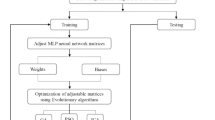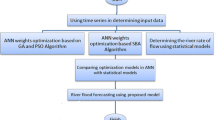Abstract
Predictions of sediment load are required in a wide spectrum of problems such as design of the dead volume of a dam, sediment transport in the river, design of stable channels, and dredging needs. Researchers have used the regression between sediment concentration and water discharge. Such relationships are obtained through the application of regression analysis in many studies. Unfortunately, in the classical regression approach to determine sediment concentration–water discharge relationships, internal uncertainties are not taken explicitly into consideration. Therefore, researchers look for non-linear methods to estimate sediment load such as artificial neural network (ANN) methods to solve non-linear problems. The main purpose of this paper is to optimize the ANN connection weights with novel social-based algorithm (SBA) to realize the sediment in Maroon river. The SBA tries to capture several people in different types of countries. They try to reach high levels. The approach illustrated feed-forward neural network optimization for sediment estimation of four Maroon river stations in Iran, which was called FF-SBA. Three inputs were presented in each station: length of river, discharge and debit. Sediment parameter on the same station is measured as the output parameter. Results of optimization algorithms such as the genetic algorithm, particle swarm optimization and imperialist competitive algorithm were compared with the SBA results, and it was found that the FF-SBA model exhibited more capability, flexibility, and accuracy in sediment training, testing, and forecasting steps for the Maroon river in Iran.














Similar content being viewed by others
References
Alp M, Cigizoglu HK (2007) Suspended sediment load simulation by two artificial neural network methods using hydrometeorological data. Environ Model Softw 22(1):2–13
Bhattacharya B, Lobbrecht AH, Solomatine DP (2003) Neural networks and reinforcement learning in control of water systems. J Water Resour Plann Manag 129:458–465
Cigizoglu HK (2004) Estimation and forecasting of daily suspended sediment data by multi-layer perceptrons. Adv Water Resour 27:185–195
Cigizoglu HK, Alp M (2006) Generalized regression neural network in modelling river sediment yield. Adv Eng Softw 37:63–68
Cigizoglu HK, Kisi Ö (2006) Methods to improve the neural network performance in suspended sediment estimation. J Hydrol 317(3–4):221–238
Droste S, Jansen T, Wegener I (2002) Optimization with randomized search heuristics- the (A)NFL theorem, realistic scenarios, and difficult functions. Theor Comput Sci 287:131–144
Gavin J, Bowden GC (2005) Input determination for neural network models in water resources applications. Part 1-background and methodology. J Hydrol 301(1–4):75–92
Hornick K, Stinchcombe M, White H (1989) Multilayer feedforward networks are universal approximators. Neural Networks 2(5):359–366
Kişi Ö (2009) Evolutionary fuzzy models for river suspended sediment concentration estimation. J Hydrol 372(1–4):68–79
Kişi Ö (2010) River suspended sediment concentration modeling using a neural differential evolution approach. J Hydrol 389(1–2):227–235
Kisia O, Shiri J (2012) River suspended sediment estimation by climatic variables implication: comparative study among soft computing techniques. Comput Geosci 43:73–82
Lippmann RP (1987) An introduction to computing with neural nets. IEEE ASSP Mag 4:4–22
Melessea AM, Ahmad S, McClain ME, Lim YH (2011) Suspended sediment load prediction of river systems: An artificial neural network approach. Agric Water Manag 98:855–866
Partal T, Cigizoglu HK (2008) Estimation and forecasting of daily suspended sediment data using wavelet-neural networks. J Hydrol 358(3—-4):317–331
Pham DT, Koc E (2006) Optimization of the weights of multi-layered perceptrons using the bees algorithm. In: Proceedings of 5th International Symposium on Intelligent Manufacturing Systems, pp 38–46
Pham DT, Liu X (1995) Neural networks for identification, prediction and control. Springer Verlag, London
Rajaee T (2011) Wavelet and ANN combination model for prediction of daily suspended sediment load in rivers. Sci Total Environ 409(15):2917–2928
Ramezani F, Lotfi S (2013) Social-based algorithm (SBA). Appl Soft Comput 13:2837–2856
Shiri J, Kisi O (2012) Estimation of daily suspended sediment load by using wavelet conjunction model. ASCE J Hydrol Eng 17(9):986–1000
Suna J, Wanga Z, Lia R, Maa D, Liub B (2011) Simulation of metal contents through correlated optimal monitoring metals of Dagu river sediments. Paper presented at the 2011 International Conference on Environment Science and Biotechnology (ICESB 2011)
Zhu Y-M, Lu XX, Zhou Y (2007) Suspended sediment flux modeling with artificial neural network: an example of the Longchuanjiang river in the Upper Yangtze Catchment, China. Geomorphology 84(1–2):111–125
Zhu Y-M, Lu XX, Zhou Y (2008) Sediment flux sensitivity to climate change: A case study in the Longchuanjiang catchment of the upper Yangtze river, China. Glob Planet Change 60(3–4):429–442
Author information
Authors and Affiliations
Corresponding author
Additional information
Communicated by C.-T. Lin.
Rights and permissions
About this article
Cite this article
Ramezani, F., Nikoo, M. & Nikoo, M. Artificial neural network weights optimization based on social-based algorithm to realize sediment over the river. Soft Comput 19, 375–387 (2015). https://doi.org/10.1007/s00500-014-1258-0
Published:
Issue Date:
DOI: https://doi.org/10.1007/s00500-014-1258-0




